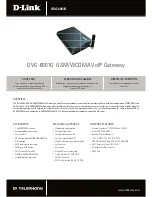
© Microhard Systems Inc.
87
4.0 Configuration
IP Protocol Config (Continued…)
TCP Client/Server:
In this mode, the IPn4G will be a combined TCP Client and Server,
meaning that it can both initiate and serve TCP connection (session) requests. Refer to the
TCP Client and TCP Server descriptions and settings described previously as all information,
combined, is applicable to this mode.
UDP Point-to-Point:
In this configuration the IPn4G will send serial data to a specifically-
defined point, using UDP packets. This same IPn4G will accept UDP packets from that same
point.
Remote IP Address
IP address of distant device to which UDP packets are sent when data received at
serial port.
Default:
0.0.0.0
Remote Port
UDP port of distant device mentioned above.
Default:
20001
Listening Port
UDP port which the IP Series listens to (monitors). UDP packets received on this
port are forwarded to the unit’s serial port.
Default:
20001
UDP Point-to-Multipoint (P):
This mode is configured on an IPn4G which is to send multicast
UDP packets; typically, the Access Point in the IPn4G network.
Multicast IP Address
A valid multicast address this unit uses to send multicast UDP packets upon
receiving data from the serial port. The default value is a good example of a valid
multicast address.
Default:
224.1.1.1
Multicast Port
A UDP port that this IP Series will send UDP packets to. The Multipoint (MP - see
the UDP Point-to-Multipoint (MP) description) stations should be configured to listen
to this point in order to receive multicast packets from this IPn4G unit.
Default:
20001
Listening Port
The UDP port that this unit receives incoming data on from multiple remote units.
Default:
20011
Time to Live
Time to live for the multicast packets.
Default:
1
(hop)
A UDP or TCP port is an
application end-point.
The IP address identifies
the device and, as an
extension of the IP
address, the port
essentially ‘fine tunes’
where the data is to go
‘within the device’.
Be careful to select a port
number that is not
predetermined to be
associated with another
application type, e.g.
HTTP uses port 80.
Multicast is a one-to-
many transmission of
data over an IP network.
It is an efficient method of
transmitting the same
data to many recipients.
The recipients must me
members of the specific
multicast group.
TTL: Time to Live is the
number of hops a packet
can travel before being
discarded.
In the context of multicast,
a TTL value of 1 restricts
the range of the packet to
the same subnet.
Содержание IPN4G
Страница 136: ... Microhard Systems Inc 136 4 0 Configuration 4 10 5 3 Modbus Modbus Data Map Image 4 10 8 Tools Modbus Data Map ...
Страница 187: ... Microhard Systems Inc 187 Appendix F GRE Example Example 2 GRE over IPsec Transport Mode ...
Страница 188: ... Microhard Systems Inc 188 Appendix F GRE Example Example 3 GRE over IPsec Tunnel Mode ...
















































